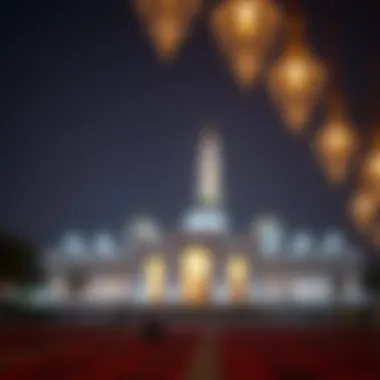Fajr Timing in Dubai: Significance and Insights


Intro
In the bustling heart of Dubai, the early morning hours hold more than just the promise of a brand new day. For many residents and visitors, these twilight moments are significant, particularly when it comes to the Fajr prayer, the first of the five daily Islamic prayers. Understanding the intricacies of Fajr timing is essential for Muslims seeking to align their religious obligations with the demands of a modern urban lifestyle.
As Dubai continues to grow, both demographically and economically, recognizing the societal and cultural nuances becomes increasingly important. This article aims to peel back the layers on Fajr timing in the context of Dubai’s dynamic environment. We will explore the mathematical calculations that govern prayer times, alongside the influence of technology in ensuring accuracy.
Moreover, we will delve into the practical aspects for both long-term residents and expatriates. The city, with its towering skyscrapers and vibrant communities, provides a unique backdrop for the observance of Fajr, raising questions about how individuals can effectively integrate these spiritual moments into their daily routines.
Through this exploration, we aim to provide valuable insights and foster a deeper understanding of how Fajr timing intersperses with everyday life in this rapidly evolving metropolis.
Prepare to embark on this journey of discovery as we unpack the layers of significance surrounding Fajr timing in Dubai, a city where tradition meets modernity.
The Essence of Fajr Timing
Fajr, the dawn prayer, holds a special place in Islamic practices, significantly affecting the daily lives of Muslims. Understanding Fajr timing not only illuminates religious obligations but also reveals its influence on the rhythm of everyday life in bustling urban settings like Dubai. For many, this prayer signifies a moment of reflection and connection with the divine, marking the beginning of a new day.
The timing of Fajr prayer is tied closely to astronomical phenomena, specifically the break of dawn. This means it’s not just a matter of personal habit; there’s an entire science behind determining the precise moment when one should pray. As this article unfolds, we’ll explore the implications of Fajr timing, how it integrates with the busy lifestyles of residents, and the evolving practices influenced by technology and modernity.
Defining Fajr
Fajr is one of the five daily prayers, starting at the break of dawn and marking the transition from night to day. This is not merely about following a schedule; Fajr serves as a reminder of the cyclical nature of time and existence. It encourages individuals to pause, reflect, and recommit themselves to their faith.
In essence, Fajr calls Muslims to experience the stillness of dawn, inviting them to engage in spiritual reflection before diving into the day’s activities. It emphasizes discipline and spiritual serenity, setting the tone for the hours ahead. In a place as dynamic as Dubai, this early morning ritual becomes an anchoring practice, aligning the physical and spiritual components of life.
Historical Context
Historically, the practice of Fajr timing can be traced back to the time of the Prophet Muhammad, who emphasized its importance deeply. In early Islamic communities, the call to prayer, or Adhan, served not just as an announcement but also as a unifying force for the believers. This historical backdrop showcases how Fajr, while fundamental to Islamic worship, is also interwoven in the social fabric of the community.
In Dubai’s context, understanding the historical significance of Fajr timing helps to appreciate its enduring relevance. Over the years, as the city evolved from a modest fishing village to a global metropolis, the essence of Fajr remained a cornerstone of life, allowing people to maintain their traditions in an ever-changing environment. Today, Fajr is more than a prayer; it embodies a commitment to heritage amidst modernization, providing a sense of community and continuity for residents and expatriates alike.
Astronomical Basis of Fajr Timing
Understanding Fajr timing is crucial not only for the spiritual practice of prayer but also for a modern lifestyle in an urban setting like Dubai. The concept of dawn, which marks the start of Fajr, is not just a matter of habit; it is underpinned by astronomical phenomena. Knowing how these elements interplay offers a deeper grasp of how Fajr works within the daily life of a Muslim.
Understanding Dawn and Dusk
Dawn is marked by a gradual lightening of the sky before sunrise. The light doesn’t just appear suddenly; it creeps upon us, a process that can be broken down into distinct phases. In Islamic terminology, Fajr can be divided into two types: the astronomical Fajr (which is an observable light in the sky) and the true Fajr (the time for prayer). In a bustling city like Dubai, distinguishing these moments holds equal importance for anyone looking to align their schedules, particularly those who are actively involved in significant daily activities.
The two main types of dawn can be denoted as:
- Civil Dawn: When there’s enough light to perform everyday activities without additional light sources.
- Nautical Dawn: When the horizon is visible at sea, allowing sailors to navigate.
The crucial part of Fajr is linked to the astronomical perspective. The Earth’s rotation, coupled with its tilt, leads to variations in light on a daily basis. Hence in Dubai, location plays a pivotal role in determining the exact timing. Knowing when exactly Fajr kicks in helps to harmonize one’s responsibilities with spiritual obligations.
Calculating Fajr Timing
The calculation of Fajr timing is slightly more elaborate than merely checking a smartphone or looking at a clock. There are specific techniques and methods used to ensure accuracy, especially in places like Dubai where the skyline and geographical features can cause discrepancies.
Mathematical Models
Mathematical models play a significant role in determining Fajr timing. They are grounded in astronomical equations that consider latitude, longitude, and the date of the year to yield precise results. One key characteristic of these models is their ability to accommodate variations in atmospheric conditions, which can affect the visibility of dawn.


These models often utilize the hour angle, which basically measures the position of the sun in relation to the observer's local horizon. The utility of the mathematical models extends beyond just being numbers on a spreadsheet; they offer a robust mechanism for determining prayer times in a consistent manner. Their reliability has made them a beneficial choice for both residents and visitors in Dubai, providing a framework to guide the daily rhythm of life with Fajr.
While mathematical models provide numerous advantages, they are not entirely without faults. For instance, local atmospheric conditions, including pollution or temperature, can affect light conditions, throwing timings off slightly. However, the precision they offer outweighs the occasional inaccuracies, making them a trusted resource.
Local Variations
Local variations also play an important role in Fajr timing. Depending on where you are in Dubai, factors like urban landscape, elevation, and even local time and time zone adjustments can cause shifts in when Fajr is observed. A major characteristic of local variations is their independence from established mathematical models; rather, they account for on-ground realities.
For example, areas closer to the coast can experience slight delays in the appearance of dawn compared to more elevated areas. This aspect often becomes evident in community settings where residents notice these differences and adjust their schedules accordingly.
Understanding local variations can significantly benefit believers in aligning their prayer schedules more accurately and meaningfully. However, it can introduce confusion for newcomers who rely solely on generic time tables. Thus, those who may be experienced or somewhat familiar with Dubai's nuances advise focusing on personal observation along with technology-based aids.
In a city that thrives on cultural diversity, knowledge of the astronomical basis behind Fajr not only informs prayers but integrates them meaningfully into the rhythm of urban life.
Fajr Timing in Dubai
Fajr timing in Dubai holds a central place within the community’s daily rhythm, intertwining religious practices with modern living. The dawn prayer signifies not just the commencement of a day but also serves as a reminder of spiritual connection and discipline. As residents navigate their busy lives, aligning daily activities with Fajr becomes a vital consideration.
In a city like Dubai, where tradition meets rapid urban development, the nuances surrounding Fajr timing are particularly significant. This is true not only for practicing Muslims but also for investors and property managers who understand that spiritual aspects can influence community dynamics. For example, proximity to mosques and facilities for worship can impact property values and community planning decisions. Thus, comprehensively understanding how time for Fajr is determined, practiced, and valued in this context offers many insights into the fabric of local life.
Current Practices in Dubai
Current practices around Fajr timing in Dubai are reflected in both individual routines and community gatherings. Residents often start their day early to perform this prayer, seamlessly melding spiritual obligations with everyday responsibilities. The call to prayer, or Adhan, echoes through the city as a gentle nudge, reminding individuals to pause and dedicate a moment to reflection and devotion.
Different communities in Dubai exhibit varied adherence to Fajr practices. Some neighborhoods might reflect tighter schedules, where local establishments open after prayers, while others might be more flexible. Understanding these dynamics can be beneficial for investors assessing their real estate strategies or home buyers looking for properties that are strategically located near places of worship.
Technological Aids
Technological advancements have vastly transformed how Fajr timing is calculated and adhered to. Many local residents rely on mobile applications and online resources to receive accurate prayer times tailored to their location. This has benefited not just devout Muslims but also those interested in community engagement and social interactions during prayer times.
Mobile Applications
Mobile applications have become the go-to tools for tracking Fajr timings. They provide prayer schedules that adjust automatically based on geographic location, which is especially important in a city with as much movement as Dubai. The key characteristic of these applications is their accuracy; they'll often include different calculation methods, allowing the user to select what aligns best with their beliefs or needs.
One unique feature of popular applications, such as Muslim Pro and Athan, is their reminder system, which sends alerts before Fajr to ensure users don’t miss out. These notifications serve as helpful nudges for busy individuals who may otherwise lose track of time amid their morning routines. However, while these apps are a boon for many, reliance on them raises questions about tech fatigue and the ambient noise of notifications, which some may find distracting.
Online Resources
Online resources further extend the reach of accurate Fajr timing. Websites often publish not just prayer times but also guidance on how to incorporate prayers into one's day. Many of these platforms, like IslamicFinder or local mosque websites, are beneficial for newcomers or expatriates seeking to connect with the community's spiritual fabric.
A defining aspect of these resources is their ability to offer insight into different prayer time calculation methods used across the world, promoting a broader understanding of Islamic practices. However, the downside can be the overwhelming amount of information available, leading to confusion for those unfamiliar with these systems. The wealth of resources can complicate what should ideally be straightforward, requiring careful navigation on behalf of the user.
Cultural Significance of Fajr
Fajr, the dawn prayer, is more than just a ritual; it holds significant cultural weight, especially in a diverse city like Dubai. This initial prayer of the Islamic day is a cornerstone of spiritual life and social routine. Its timing at early dawn is deeply symbolic, representing the transition from darkness to light, both literally and spiritually. This transition echoes the Islamic ethos of seeking guidance and clarity in life's journey.
The act of performing Fajr is viewed as a commitment to one's faith, reflecting dedication and discipline. This is especially pertinent in a bustling city like Dubai, where the fast-paced environment can often eclipse spiritual observances. For many, the call to prayer serves as a gentle reminder to pause and reconnect with one's beliefs amidst the urban rush. To some, missing this prayer may feel like missing the essence of their identity. Such practices not only reinforce individual spirituality but also strengthen community bonds among believers.
Fajr in Daily Life
In daily life, Fajr signifies a moment of quiet reflection before the day begins. For many residents, this early hour is a time for personal introspection, connecting with oneself and setting intentions for the day ahead. The tranquility of this predawn hour allows individuals to engage in prayer, meditation, or even light exercise, all while the rest of the city remains asleep.


The significance of Fajr also extends into practical living. In Dubai, where the sunrise comes with the hustle and bustle of the day, waking early for Fajr allows homeowners and expatriates to align their daily tasks with the natural rhythms of light. Morning routines often incorporate a blend of Fajr prayers followed by plans for work or family activities. People often organize their schedules around this prayer, ensuring that their spiritual commitments align with their professional duties.
- Benefits of incorporating Fajr into daily life:
- Enhanced Productivity: Early risers often report increased focus and energy throughout the day.
- Mental Clarity: The quiet time allows for thoughtful planning and clarity, paving the way for more productive decision-making.
In addition to personal routines, the communal aspect of Fajr is significant. Mosques across Dubai often witness a gathering of the faithful, who come together to pray and foster a sense of belonging. This communal prayer creates an unspoken bond, reinforcing the fabric of society while encouraging social interaction and support among individuals and families.
Spiritual Importance
Fajr holds a profound spiritual significance in Islam. It is a time when the faithful seek blessings and guidance for the day. Many believe that engaging in the Fajr prayer paves the way for a more blessed and productive day, as it is a moment to turn one's intentions towards the divine. This perspective is echoed in various teachings of the Prophet Mohammed, emphasizing the value of early prayer as a means to gain divine favor.
The spiritual ambiance surrounding Fajr is not merely about the act of prayer but stems from the atmosphere it cultivates. During these hours, the world is still. The peacefulness allows for an intimate connection with God, leading to a profound sense of peace and contentment. Many also utilize this time for personal supplications, asking for guidance in their career decisions, relationships, and even property investments.
The value placed on this morning prayer in Dubai transcends individual faith, impacting community dynamics and even cultural traditions. It influences societal norms and daily schedules, ensuring that spiritual growth remains intertwined with modern living. In essence, Fajr is a beacon of light that illuminates the path for believers, both in a spiritual and practical sense.
"Fajr is not just a prayer; it’s where faith meets the dawn of a new day."
As residents of Dubai navigate the complexities of urban life, the Fajr prayer reminds them to remain rooted in their cultural traditions, nurturing not only their spiritual selves but also their community ties.
Challenges of Urban Living
Urban environments like Dubai present a unique set of challenges when it comes to observing Fajr prayer timing. In the hustle and bustle of a fast-paced city, where skyscrapers touch the clouds and the culture is a blend of tradition and modernity, the act of waking up before dawn to pray can feel more complicated than it appears. The issue is not just about finding the right time but also about navigating through the various elements that affect this sacred practice.
Balancing Modernity with Tradition
Living in a city that embodies rapid growth and development can often feel at odds with traditional practices. The vibrant nightlife and the allure of social activities might tug at the strings of daily routines, making it easy to prioritize modern conveniences over age-old customs. For individuals residing in Dubai, balancing these two aspects could involve thoughtful decision-making about how to structure their evenings and mornings.
- Cultural Integration: Many expatriates find themselves adapting to the local customs. Recognizing the importance of Fajr not only enhances religious life but also fosters a sense of belonging within the community.
- Social Obligations: Late-night events and social gatherings may inadvertently encroach upon the early morning prayer time, leading individuals to scramble in the early hours.
Additionally, the spiritual richess inherent in Islam encourages people to honor their traditions even amidst the urban commotion. It emerges as a matter of personal and communal identity, where respecting Fajr helps solidify their roots while still enjoying what the modern world offers.
Adapting Schedules
Adapting to a schedule that accommodates Fajr prayer involves more than just hitting the snooze button. For many, it’s about applying strategies that ensure the early hours are respected, despite the many distractions of urban life.
- Routine Adjustments: To successfully wake up for Fajr, many residents create evening rituals. This can include setting an earlier bedtime or reducing evening activities that conflict with prayer time.
- Technology Utilization: With a plethora of apps and online resources available, determining the exact timing for Fajr becomes a simpler process. Leveraging technology can remind individuals when it is time to wake, so they don't lose track of time while engrossed in daily distractions.
- Community Support: Establishing a network within local mosques or community groups often helps in encouraging each other to maintain these schedules. It cultivates an environment where adhering to prayer times, especially Fajr, becomes a shared priority.
Practicing Fajr amidst urban challenges not only nourishes one’s spiritual life but also enriches community ties, fostering a stronger sense of belonging.
In essence, while the challenges of urban living in Dubai may place certain pressures on traditional practices, there remains a path toward embracing these sacred times. Acknowledging the significance of Fajr and making deliberate choices can allow residents to navigate the urban landscape while honoring their faith.
Implications for Real Estate Decisions
Location Considerations
Proximity to Mosques
When considering the proximity to mosques, its impact on real estate becomes apparent. Living near a mosque allows for easier access to daily prayers, and it contributes to community cohesion. Families with young children or elderly members particularly benefit from such locations. It’s a common understanding that having a mosque within a stone's throw provides convenience, but it goes further than that; it fosters a sense of belonging and community engagement. Moreover, properties located near mosques tend to have better resale value, making them a popular choice among investors.
The unique feature of these proximities is not just the ease of access for prayer but the vibrancy it adds to the neighborhood. Now, although advantageous, some may argue there could be a downside—the sounds of the adhan during early mornings might not sit well with everyone, especially those not accustomed to such routines. Yet, this characteristic is more a testament to the religious fabric of Dubai than a deterrent.


Community Planning
Community planning plays a significant role when discussing Fajr timing within the real estate context. Well-planned residential areas take prayer times into account, integrating mosques thoughtfully among the housing developments. This strategic layout not only meets the practical needs of residents but also supports the broader social architecture of the community.
One notable characteristic is the development of family-friendly neighborhoods that emphasize the importance of communal prayer. Properties in these planned areas often come with added attraction—a sense of tranquility that can be hard to find in bustling urban life. The unique feature here is the inclusion of community centers, parks, and recreational spaces designed to promote gatherings before or after prayers, fostering stronger neighborly ties. However, with the rise of high-density living, some developments might overlook this integration, leading to isolated experiences for residents. This can cause a churn in real estate interests as buyers look for balance between modern amenities and cultural practices.
Property Management Perspectives
For property managers, understanding Fajr timing is about more than just accommodating religious practices; it's about optimizing tenant engagement and satisfaction. A managerial perspective on this requires not just the acknowledgment of prayer times but also the implementation of services that can enhance the living experience around those times. Whether it’s ensuring common areas are well-lit for early morning tenants or scheduling maintenance activities that respect prayer times, every detail can influence tenant retention and satisfaction metrics.
Additionally, property managers should consider how to market these features effectively to potential investors, emphasizing the value of community ties and convenience. An awareness of Fajr can elevate the perceived value of properties, making them attractive not only for personal occupancy but also as potential rental properties in a city filled with expatriates who might prioritize accessibility to religious practices.
"Location, accessibility, and community engagement are key factors for property decisions among the diverse demographics of Dubai."
By weaving the threads of cultural significance into the fabric of real estate strategies, stakeholders in this market can create environments that honor both tradition and modernity, ultimately supporting the goals of everyone involved.
Future Trends in Fajr Timing Determination
As the world progresses, so does technology, and this evolution profoundly impacts various aspects of our lives. When looking at prayer times, especially the determination of Fajr timing in Dubai, it's important to realize how these advancements shape the future. The way we account for Fajr is not just a religious observance but also a matter of personal and community wellbeing.
Advancements in Technology
The role of technology in defining Fajr timing has been nothing short of revolutionary. Armed with smartphones and the Internet, most individuals rely on applications that have algorithms specifically designed to calculate prayer times. Programs like IslamicFinder and the Athan app use precise geographical data along with astronomical formulas to deliver accurate timings. This means one doesn't need to rely solely on mosque announcements or printed timetables.
Moreover, innovations in artificial intelligence and machine learning allow apps to evolve continuously. For instance, if someone travels from Dubai to Egypt, algorithms adapt calculations based on the new location, considering factors like elevation and latitude. This seamless integration ensures that practitioners can maintain their Fajr rituals without interruption, regardless of where they are.
In the context of community management, property developers can also benefit from such advancements. Smart buildings now feature integrated prayer time notifications, harmonizing architectural designs with spiritual practices. As a resident of a modern apartment, it’s rather reassuring to receive timely alerts, serving as gentle nudges to participate in spiritual observance.
Impact on Lifestyle Choices
The way Fajr timing is determined has significant implications for an individual’s daily routine. With precise timings calculated through advanced tools, people can make informed choices about their schedules. Everyone knows the struggle of waking up at ungodly hours, yet with accurate Fajr timing, many individuals find it easier to plan their sleep and awakening habits.
A structured approach to one’s day around Fajr can also have wider societal benefits. For instance, if Fajr prayer is performed consistently, it sets a tone of discipline and focus for the day ahead. The early morning meditation invites not just spirituality but often a sense of calm, presenting an opportunity for personal reflection.
Furthermore, for business owners and employees in Dubai, this might mean balancing their work hours around Fajr. It leads to a healthier work-life equilibrium when morning prayer coincides with a well-thought-out breakfast routine, enhancing productivity. Individuals may find avoided midday lulls in energy, as starting the day with Fajr offers emotional and mental clarity.
In sum, as we continually navigate aligning technology with personal and communal needs, Fajr timings in Dubai are poised for a future that embraces precision. This evolution is not simply about numbers but also shapes quality of life, bridging spiritual practice and modern living into a harmonious existence.
In essence, the future of Fajr timing determination is about adapting technology and spirituality. Ensuring that every individual can engage with their faith while accommodating the modern pace of life.
For more insights, check resources like Wikipedia on Islamic Prayer, or join communities discussing these impacts on platforms like Reddit.
Closure
In closing, the exploration of Fajr timing in Dubai reveals not just the significance of dawn prayers in Islamic practice, but also highlights how these ancient traditions intertwine with the modern urban fabric of the city. Understanding when and why Fajr takes place is crucial, especially for residents and expatriates navigating their daily schedules. As this article elucidates, accurate Fajr timings are not simply practical necessities; they embody cultural values and religious observances that enhance community cohesion.
Summary of Key Insights
Throughout this article, we’ve delved into several key aspects that illuminate the importance of Fajr timing.
- Cultural Relevance: Fajr serves as a reminder of spiritual duties that ground individuals in their faith.
- Astronomical Observations: The calculations behind Fajr highlight the marriage between science and spirituality, embodying the importance of celestial phenomena in Islamic practice.
- Technological Integration: Modern innovations, like mobile applications, have made it easier for the community to connect with their faith through real-time Fajr notifications.
- Lifestyle Adjustments: Adapting personal routines to align with Fajr can foster a deeper relationship with spiritual practices and connect individuals with the larger community.
In essence, understanding Fajr timing is invaluable for both personal and communal growth.
Call for Community Awareness
As residents of Dubai, it is essential for the community to remain aware of Fajr timings and their implications. Sharing knowledge and engaging in conversations around the importance of these timings can foster a sense of unity and understanding across demographic lines. Community centers and mosques could play pivotal roles in disseminating this information. Furthermore, fostering an atmosphere of respect for those observing Fajr can enrich social relationships and contribute positively to the city’s diverse tapestry.
Encouraging community events or discussions can facilitate greater awareness and appreciation of the role that Fajr plays in daily life. This shared awareness not only enhances spiritual practices but also strengthens bonds, making Dubai a more cohesive place to live for everyone, regardless of their background.















